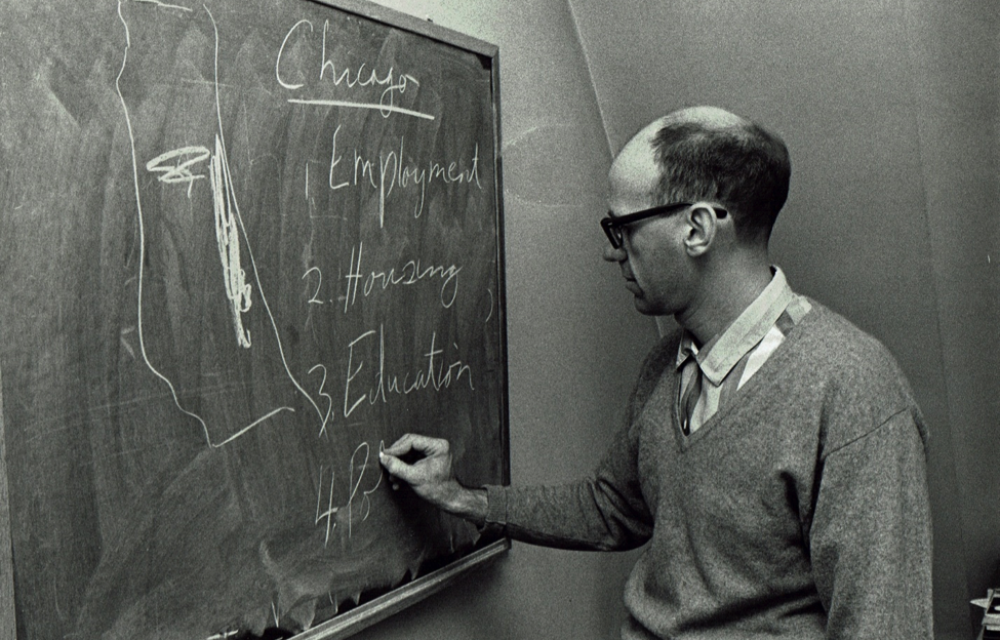Synopsis by Chelsea Birchmier
“Northern Segregation as a System: The Chicago Schools” first appeared in the journal Equity & Excellence in Education, formerly Integrated Education, in 1965. In this piece, Baron argues that racial subjugation in the northern U.S. was tied to peculiar northern racial institutions rather than being inherited entirely from the South. Additionally, he emphasizes an institutional framework of northern race relations in contrast to a framework dominated by individual white prejudices and Black adjustment difficulties. While the origins of U.S. race relations lay in the southern plantation economy, the northern metropolis had developed and perpetuated its own racial institutions. In contrast to southern segregation, which was upheld by law and its enforcement by state police, Chicago had achieved a high level of segregation in schools in the absence of legal segregation. This, he suggests, was maintained via a “complex of interacting and mutually supportive institutions whose combined effect is greater than the sum of the effects of each institution considered singly,” a framework he further develops in “The Negro Worker in the Chicago Labor Market” (1965) and “The Web of Urban Racism” (1968). Racial segregation in schools, then, was supported and reinforced by the dual labor market, job discrimination, housing segregation, the lack of Black power, and an ideology of racism.
Baron then details how this system of northern segregation operated rather overtly in the Chicago Public Schools via dual Black and white sub-systems that were spatially and socially distant. In Chicago, only 18% of elementary schools were integrated; while high schools were more integrated, they were internally segregated via track systems. Similarly, faculty and administrators were segregated such that Black teachers and principals were concentrated in Black-segregated schools. One feature of northern segregation systems was the presence of exceptions to patterns of separation, in contrast to the absolute separation characteristic of legal segregation, exemplified by the presence of a few integrated schools in Chicago. Yet, even these schools were often transitionally integrating from white-segregated to Black-segregated schools. A second feature of such systems was the inferiority of the Black subsector. In Chicago, Black schools were inferior in inputs—more pupils per class, less money spent per pupil, less concern for needs of the community, lower expectations—resulting in inferior outputs—lower grades, higher dropout rates, lower self-esteem. The Civil Rights Movement, however, led to some improvements in inputs, which helped the disparities in outputs from increasing. Third, the system operated as one of racial subjugation. While Black people were able to improve their absolute conditions via education, their position relative to white people remained stagnant or worsened.
Baron lays out the other barriers that reinforced and were reinforced by the school system in Chicago. First, residential segregation maintained school segregation via a neighborhood school policy, while school segregation maintained residential segregation by the movement of whites out of integrated neighborhoods to avoid inferior schools for their children. Second, the dual labor market upheld school segregation through impoverishment and family instability while the schools produced inferior outputs in skills that upheld Black workers’ degraded relative income and occupational status as part of the dual labor market. Third, the ideology of racism legitimized school segregation while school segregation indoctrinated children with racist ideology. Fourth, the lack of Black political power made it so that the strong and continuous organization of Black Chicagoans against school segregation had not achieved necessary change, while the school system perpetuated and established this lack of power as a norm. Finally, racial discrimination, while not the fundamental basis of racial segregation, served to uphold institutionalization by punishing people who did not conform to defined role expectations.
That racial segregation in the Chicago school system continued after reducing blatantly racist policies and implementing colorblind boundary drawing policies was evidence for Baron’s argument that the Chicago Public School system was institutionalized, subjugated Black youth to second-class status, and was reinforced by a constellation of other racial institutions. Given these features, Baron investigates the potential of state and federal legal means to fight school segregation. At the state level, the Armstrong Law of 1963, which forbade racial separation in drawing school boundaries, did not contain enforcement provisions and had little to no effect on Chicago schools, in contrast to the Massachusetts law of 1965, which provided for the withholding of funds for schools that did not make progress toward reducing segregation. He then describes two federal laws relevant to school segregation. The first, the Elementary and Secondary Education Act of 1965, responding to public pressure from the Civil Rights Movement, offered compensatory education funds for children from low-income families, which helped to redistribute funds but did not address segregation directly. The second, Title VI of the 1964 Civil Rights Act, included provisions for withholding federal funds from discriminatory institutions. The success of this act in a northern system relied on a broad interpretation of discrimination that included institutions and not just individual discrimination and clear public policy, which was rare from a federal government with a history of accommodating segregation. When the Office of Education attempted to follow through on Title VI sanctions against Chicago schools, they were attacked by Illinois congresspersons, Superintendent Benjamin C. Willis, and Mayor Richard J. Daley, who asked the President to restore the funds, resulting in a settlement favoring the Chicago Public School system.
Baron concludes that the ability of the Civil Rights Act to make change in the Chicago School System had been hindered by these limitations, and that public policy and national leadership would have to do more to create serious change in northern segregation systems. In turn, changes in public policy required “an increase in the effective power of the Negro and civil rights forces.”

